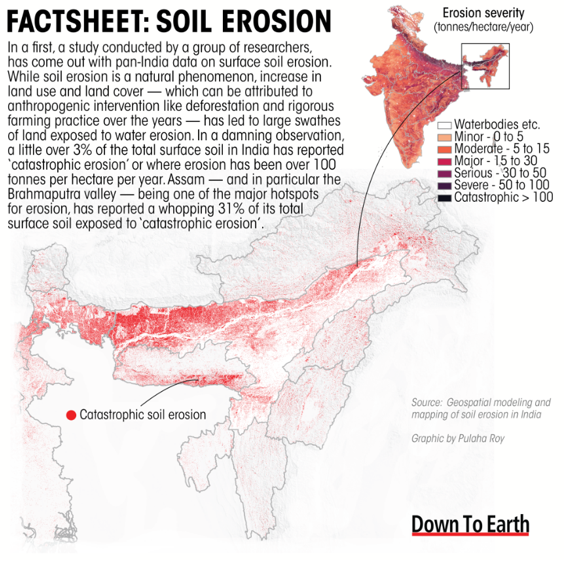

Context
A new study has revealed a worrying trend for India’s soil health. Nearly 30 per cent of the country’s landmass is experiencing “minor” soil erosion, while a critical 3 per cent faces “catastrophic” topsoil loss.
1: Dimension- Findings and Concerns
- The biggest hotspot for soil erosion in the country is the Brahmaputra Valley in Assam.
- The north-eastern state Assam lost close to 300 square kilometres or 31 per cent of its surface soil to “catastrophic” erosion.
- Apart from the Brahmaputra Valley, the lower reaches of the Himalayas are characterised by moraine or loose soil and highly unstable slopes.
- Topsoil is vital for agriculture as it holds nutrients and moisture essential for plant growth. Erosion significantly reduces fertility and can lead to decreased crop yields.
- Carbon:Land degradation reduces the soil’s ability to absorb carbon.
- Worsened climate change:Land degradation and climate changefuel each other.
- Threat to food security:Degraded land in the country is either rainfed farmland, responsible for the food security of the country, or forest land that offers the best defence against climate change.
- Economic loss: Lost productivity can weigh heavily on the economy.
2: Dimension- Factors killing soil & solution
- Farming practicessuch as tilling break up the soil and destroy its natural structure, killing many of the vital bacteria.
- Agricultural chemicalscan alter the physiological, metabolic and biochemical behaviour of microbiota in the soil. This can disrupt the relationships between plants and microbes, decreasing nutrient bioavailability.
- Pressures of population growth, food insecurity and agricultural intensification are leading to widespread soil degradation. This degradation can take many forms- degradation, erosion, acidification, salinization
- Others: Burning of crop residues, land misuse and soil mismanagement and climate change
- Solution: Replenishment, adopting organic practice (inter-cropping, mixed cropping, practicing crop rotation, Agroforestry, Permaculture, adopting biofertilizers.
|
Fact Box Soil
Government Interventions
|




